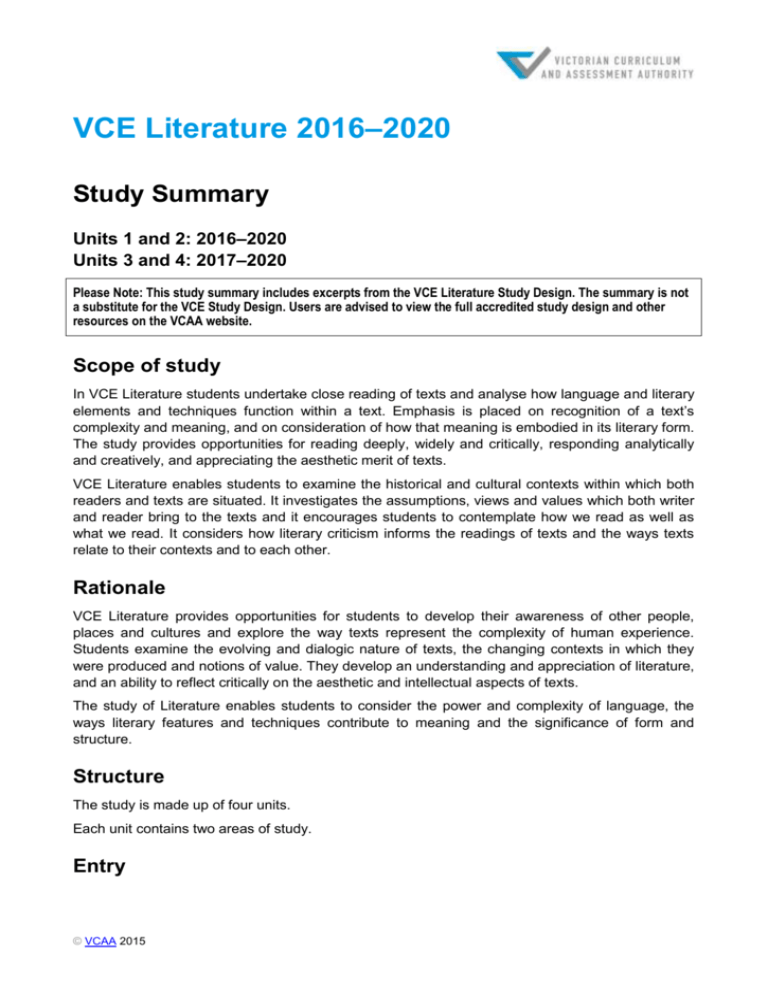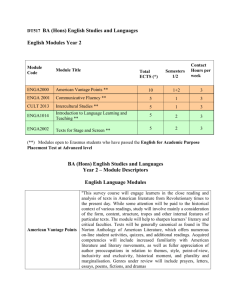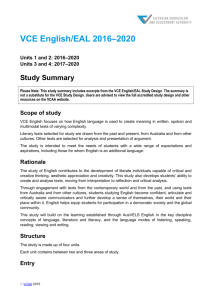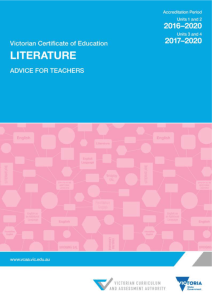VCE Literature 2016*2020 - Victorian Curriculum and Assessment
advertisement

VCE Literature 2016–2020 Study Summary Units 1 and 2: 2016–2020 Units 3 and 4: 2017–2020 Please Note: This study summary includes excerpts from the VCE Literature Study Design. The summary is not a substitute for the VCE Study Design. Users are advised to view the full accredited study design and other resources on the VCAA website. Scope of study In VCE Literature students undertake close reading of texts and analyse how language and literary elements and techniques function within a text. Emphasis is placed on recognition of a text’s complexity and meaning, and on consideration of how that meaning is embodied in its literary form. The study provides opportunities for reading deeply, widely and critically, responding analytically and creatively, and appreciating the aesthetic merit of texts. VCE Literature enables students to examine the historical and cultural contexts within which both readers and texts are situated. It investigates the assumptions, views and values which both writer and reader bring to the texts and it encourages students to contemplate how we read as well as what we read. It considers how literary criticism informs the readings of texts and the ways texts relate to their contexts and to each other. Rationale VCE Literature provides opportunities for students to develop their awareness of other people, places and cultures and explore the way texts represent the complexity of human experience. Students examine the evolving and dialogic nature of texts, the changing contexts in which they were produced and notions of value. They develop an understanding and appreciation of literature, and an ability to reflect critically on the aesthetic and intellectual aspects of texts. The study of Literature enables students to consider the power and complexity of language, the ways literary features and techniques contribute to meaning and the significance of form and structure. Structure The study is made up of four units. Each unit contains two areas of study. Entry © VCAA 2015 VCE Literature 2016–2020 There are no prerequisites for entry to Units 1, 2 and 3. Students must undertake Unit 3 prior to undertaking Unit 4. Units 1 to 4 are designed to a standard equivalent to the final two years of secondary education. Text selection Units 1 and 2 In Units 1 and 2, text selection is a school-based decision, and must be made in accordance with the instructions provided on page 8 of the VCE Literature Study Design. Units 3 and 4 In Units 3 and 4, text selection must be made in accordance with the instructions provided on page 15 of the VCE Literature Study Design. Unit 1: Approaches to literature In this unit students focus on the ways the interaction between text and reader creates meaning. Students’ analyses of the features and conventions of texts help them develop responses to a range of literary forms and styles. They develop an awareness of how the views and values that readers hold may influence the reading of a text. Unit 2: Context and connections In this unit students explore the ways literary texts connect with each other and with the world. They deepen their examination of the ways their own culture and the cultures represented in texts can influence their interpretations and shape different meanings. Students consider the relationships between authors, audiences and contexts and analyse the similarities and differences across texts and establish connections between them. They engage in close reading of texts and create analytical responses that are evidence-based. Unit 3: Form and transformation In this unit students consider how the form of a text affects meaning, and how writers construct their texts. They investigate ways writers adapt and transform texts and how meaning is affected as texts are adapted and transformed. They consider how the perspectives of those adapting texts may inform or influence the adaptations. Students develop creative responses to texts and their skills in communicating ideas in both written and oral forms. Unit 4: Interpreting texts In this unit students develop critical and analytic responses to texts. They investigate literary criticism informing both the reading and writing of texts. Students develop an informed and sustained interpretation supported by close textual analysis. Assessment Satisfactory completion © VCAA 2015 Page 2 VCE Literature 2016–2020 The award of satisfactory completion for a unit is based on a decision that the student has demonstrated achievement of the set of outcomes specified for the unit. This decision will be based on the teacher’s assessment of the student’s performance on assessment tasks designated for the unit. Levels of achievement Units 1 and 2 Procedures for the assessment of levels of achievement in Units 1 and 2 are a matter for school decision. Units 3 and 4 The Victorian Curriculum and Assessment Authority will supervise the assessment of all students undertaking Units 3 and 4. In VCE Literature, students’ level of achievement will be determined by School-assessed Coursework (SAC) as specified in the VCE study design, and external assessment. Percentage contributions to the study score in VCE Literature are as follows: Unit 3 School-assessed Coursework: 25 per cent Unit 4 School-assessed Coursework: 25 percent End-of-year examination: 50 per cent. © VCAA 2015 Page 3










